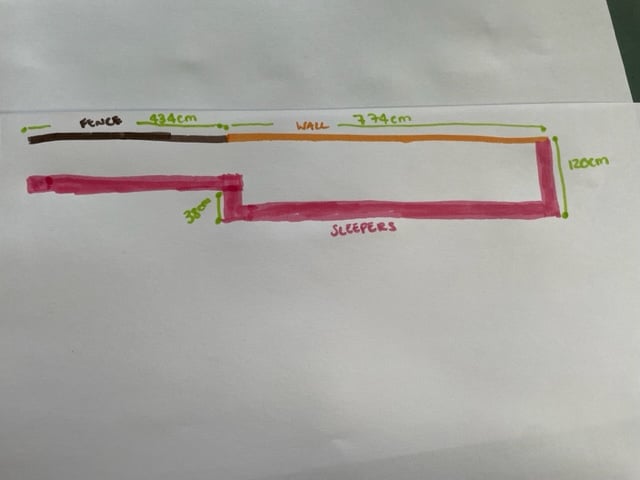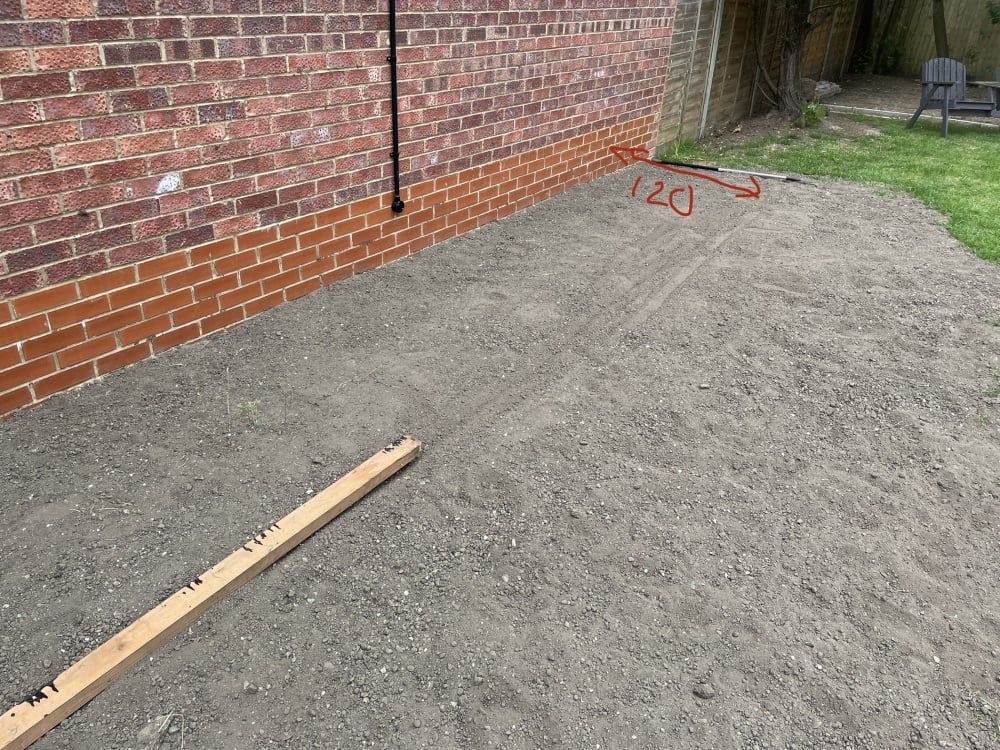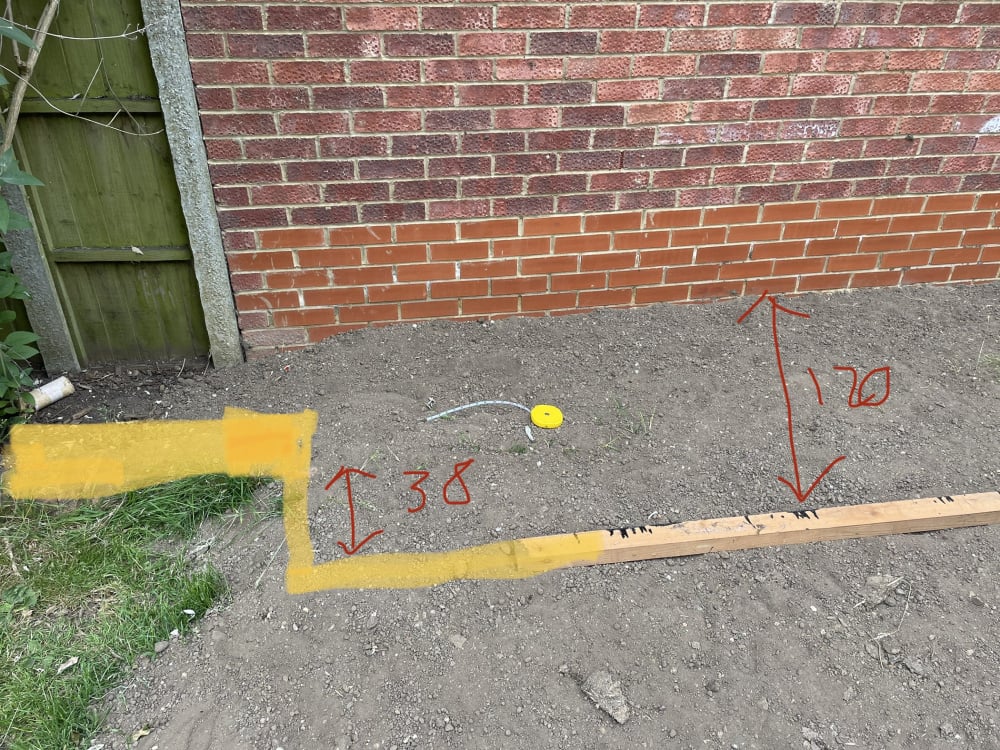This Forum will close on Wednesday 27 March, 2024. Please refer to the announcement on the Discussions page for further detail.
Anyone experienced in building raised beds with sleepers able to help me work out how many I need?
I appreciate that sounds overly simple, add up the length of the lines you need and then you've got it, right?
Except I've now confused myself by trying to work out the best way to do it as of course sleepers come in set sizes, and I need to work out the most cost efficient way of doing it whilst also using sensibly long pieces, rather than any bitty offcuts... and i'm not looking at perfect rectangle either. Also I have now spent about 30 odd mins typing this and realised I've probably gone into far to much backstory.. apologies... You can probably skip to the last 4/5 paragraphs if it's too long!
So the plan is to build a raised bed against the wall of our neighbours semi new extension. This was agreed with them in advance, as they suggested that as their extension would be an eyesore they offered to have it built to withstand soil against it and put up a trellis and buy some climbers to try and make it less in your face, once we'd evened up the steep slope and added a raised bed.
Our house is a long thin sideways rectangle only one room deep, and the garden mirrors it (so comparatively wide left to right, but very shallow front to back). This bed/wall is right opposite all of our downstairs windows, and due to the shape of the garden, their wall is rather imposing.
Before I started this project, the garden was on a gentle slope away from the house, until about 3/4m before their house wall where it began to slope sharply. There was an original flower bed in front of the wall, probably 50/60cm front to back, with an old brick wall in front separating the bed from the grass.
I decided to try and level the worst of the slope. I ordered 7 tons of loose topsoil and filled in the old bed, and then the worst of the dip in the lawn (that was a very long day and many trips with a wheelbarrow!). I had originally said I was just going to smooth out the most obvious dip as the garden is a bit unlevel all over but it's way too big a job for a complete novice newbie like me to tackle alone (I did speak to a landscaper, but was told £15-20k to level it, which is absolutely not possible). I'm now humming and ahhing whether actually I get a few more tons as there is still a bit of a gentle slope towards the topsoil... tho far more subtle than it was.
So the next part of the plan was to build the raised bed, then get another delivery of topsoil or compost to fill the beds and then lay turf in front of them. (Then we can start on the next are, slightly further back where we have just removed a shed)...
The bed is going to be square P shaped as whilst the wall has been designed to have soil against it, and was built with engineered bricks, but the fence obviously isn't- so we can't go as deep. The lawn in front of the bed/fence area is very gently sloping, but not enough of an issue to try and fiddle with. The above means that the small brick wall that has been buried in the wider proposed section will stick out of the ground and be visible here - I can't get the bed deep enough to cover it well enough to plant above it. Therefore the raised bed in front of the fence will be lower in height than the wall section, and narrower as we plan to sit the sleepers on the wall there. Depending on which way we put the sleepers in, we will probably have one less layer on the fence section, making the sleeper wall lower. My understanding is that you can buy special fixing stakes about 45cm that then screw into the sleepers, so that they don't move with the weight of the soil behind?
I think I want to put the sleepers in tall side up, as if we went the other way then you need twice as many and obviously costs twice as much. However, if I went short side up then the sleepers on the left hand side in front of the fence will sit perfectly on the bricks as the wall is about 20cm wide. Obviously which way they are placed will impact the length required as I think they would then vary by 10cm (the difference between the flat and tall sides)? But this is where I am completely struggling to get my head around things!
If I use a local supplier they will cut the sleepers to size for a small fee. So I need to work this out properly before ordering (rather than lining it up and cutting it at home after seeing how it looks/fits). Their sleepers come in 2.4m x 20cm x 10cm or a longer 3m version (tho currently out of stock). In the diagram below the 38cm is from the far edge of the sleeper to the start of the brick wall. If necessary for convenience I can tweak the 120cm depth of the bed. I just can't move where the old brick wall is and therefore where the tail of the P shape on the left has to be.
So I was wondering (after what feels like the life story of this section of my garden!), if anyone can please help me work out the best way to do this?
THANK YOU!



Except I've now confused myself by trying to work out the best way to do it as of course sleepers come in set sizes, and I need to work out the most cost efficient way of doing it whilst also using sensibly long pieces, rather than any bitty offcuts... and i'm not looking at perfect rectangle either. Also I have now spent about 30 odd mins typing this and realised I've probably gone into far to much backstory.. apologies... You can probably skip to the last 4/5 paragraphs if it's too long!
So the plan is to build a raised bed against the wall of our neighbours semi new extension. This was agreed with them in advance, as they suggested that as their extension would be an eyesore they offered to have it built to withstand soil against it and put up a trellis and buy some climbers to try and make it less in your face, once we'd evened up the steep slope and added a raised bed.
Our house is a long thin sideways rectangle only one room deep, and the garden mirrors it (so comparatively wide left to right, but very shallow front to back). This bed/wall is right opposite all of our downstairs windows, and due to the shape of the garden, their wall is rather imposing.
Before I started this project, the garden was on a gentle slope away from the house, until about 3/4m before their house wall where it began to slope sharply. There was an original flower bed in front of the wall, probably 50/60cm front to back, with an old brick wall in front separating the bed from the grass.
I decided to try and level the worst of the slope. I ordered 7 tons of loose topsoil and filled in the old bed, and then the worst of the dip in the lawn (that was a very long day and many trips with a wheelbarrow!). I had originally said I was just going to smooth out the most obvious dip as the garden is a bit unlevel all over but it's way too big a job for a complete novice newbie like me to tackle alone (I did speak to a landscaper, but was told £15-20k to level it, which is absolutely not possible). I'm now humming and ahhing whether actually I get a few more tons as there is still a bit of a gentle slope towards the topsoil... tho far more subtle than it was.
So the next part of the plan was to build the raised bed, then get another delivery of topsoil or compost to fill the beds and then lay turf in front of them. (Then we can start on the next are, slightly further back where we have just removed a shed)...
The bed is going to be square P shaped as whilst the wall has been designed to have soil against it, and was built with engineered bricks, but the fence obviously isn't- so we can't go as deep. The lawn in front of the bed/fence area is very gently sloping, but not enough of an issue to try and fiddle with. The above means that the small brick wall that has been buried in the wider proposed section will stick out of the ground and be visible here - I can't get the bed deep enough to cover it well enough to plant above it. Therefore the raised bed in front of the fence will be lower in height than the wall section, and narrower as we plan to sit the sleepers on the wall there. Depending on which way we put the sleepers in, we will probably have one less layer on the fence section, making the sleeper wall lower. My understanding is that you can buy special fixing stakes about 45cm that then screw into the sleepers, so that they don't move with the weight of the soil behind?
I think I want to put the sleepers in tall side up, as if we went the other way then you need twice as many and obviously costs twice as much. However, if I went short side up then the sleepers on the left hand side in front of the fence will sit perfectly on the bricks as the wall is about 20cm wide. Obviously which way they are placed will impact the length required as I think they would then vary by 10cm (the difference between the flat and tall sides)? But this is where I am completely struggling to get my head around things!
If I use a local supplier they will cut the sleepers to size for a small fee. So I need to work this out properly before ordering (rather than lining it up and cutting it at home after seeing how it looks/fits). Their sleepers come in 2.4m x 20cm x 10cm or a longer 3m version (tho currently out of stock). In the diagram below the 38cm is from the far edge of the sleeper to the start of the brick wall. If necessary for convenience I can tweak the 120cm depth of the bed. I just can't move where the old brick wall is and therefore where the tail of the P shape on the left has to be.
So I was wondering (after what feels like the life story of this section of my garden!), if anyone can please help me work out the best way to do this?
THANK YOU!



0
Posts
Thanks for the reply!
Yes that's the plan... on the basis that is what the neighbours have told us to do, as that was always the plan before they built the extension, so they discussed it with builders etc and used what they called engineered bricks (they are the brighter ones in the picture). I know even less about construction than gardening as you can probably tell! The neighbour lent me a better spade when I was moving the soil so knows we are finally getting the wheels in motion with regard to building beds and was encouraging.
But I would be surprised (and actually pretty ticked off with the builders/surveyors etc to say the least!) if the plan that was agreed between the professionals and both us and neighbours when they put in planning permission isn't actually viable without significant outlay to us. (Prior to the extension there was a small, single story, flat roofed garage there and due to the difference in ground level, the roof was the same height as the fences on either side. Their house was on the other side of the garage). We now have the side of their house as our boundary- two storey plus a loft. We like our neighbours so wanted to be helpful, however, it has really impacted our space- hence everyone agreeing in advance that they would make sure we could build up a raised bed so that we could cover their wall with greenery to try and make it less awful.)
The whole street is on a slope, their garden and house is about 3ft lower than the ground level in our garden (at its lowest point). We let them use our garden for access when they were building and so we popped out one of the fence panels- I was quite surprised at how big the drop was! So actually, thinking about it, the inside of the house along that wall is lower than our garden level before I even start levelling it. As the extension was done about 18m ago now it must all be ok or they would have had issues already.
So I'm hoping its all ok... I think it must be bearing in mind that their house is so much lower than our garden. But thank you for checking!
I’m afraid I did not really understand what was going on to the left of the extension but I do not like the sound of a raised bed against a wooden fence. If you really want raised beds, can you just restrict it to a simple rectangle against the extension? It helps because this firm is near me but I buy sleepers from here
www.uksleepers.co.uk
And the fixing brackets from
www.indoorsoutdoors.co.uk
If I did build a bed, it would just be one sleeper high to keep it well below the top layer of engineering bricks and would dig over well and incorporate manure or garden compost into the existing soil. I might go to a double height line of sleepers if I was very confident the damp proof course would not be compromised.
Previously there was a difference of over 2ft side to side and quite a slope back to front, so there was a lot of levelling to do.
The raised beds required ~ 30ton of topsoil/manure
This is what I designed-
Billericay - Essex
Knowledge is knowing that a tomato is a fruit.
Wisdom is not putting it in a fruit salad.
But I was also told ages ago that engineered bricks are fine for such a purpose when I had my front wall replaced with them.
The previous ordinary bricks were flaking a bit, then after a rowdy night at the local football club a few years ago some of the 'fans' decided they'd kick down all the front walls down my road in the early hours....
I found this
From-
https://brickhunter.com/blog/engineering-bricks-what-can-they-be-used-for#:~:text=Engineering%20bricks%20are%20also%20used,bridges%2C%20canals%20and%20tunnels%20too.
Common and (not so common) uses of engineering bricks
So, we mentioned above that engineering bricks are ideal for use in building foundations. This is probably the main reason you would come across them.
Typically, you would lay a couple of courses of brick in the footings below ground, and two courses of the same engineering brick above ground. If you look at a lot of houses, you can often see two courses of a different colour at the bottom.
Engineering bricks are also used for building Damp Proof Courses. A damp proof course stops moisture from rising in the structure. As we mentioned above these bricks are ideal as they have a low water absorption.
They've also been used for bridges, canals and tunnels too. Again, the low water absorption and durability are the main concerns when building these important structures.
It's not just houses either. British bricks like the ones we mentioned above have been used in some pretty famous structures around the world.
The base of the iconic Empire State Building in New York was built using red Accrington or 'Nori' bricks, which were made not far from the Lancashire town where they get their name.
In some cases, Class A bricks have been used for their colour. The Staffordshire Blue brick in particular has been used in classic buildings such as this old church in the past and can now be seen in modern developments that want to get a distinctive, dark, urban look.
Billericay - Essex
Knowledge is knowing that a tomato is a fruit.
Wisdom is not putting it in a fruit salad.